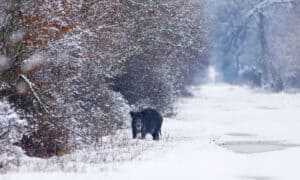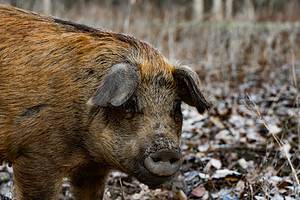The population of wild hogs is as ubiquitous and varied as their names. The invasive species are also known as feral pigs, swine, and wild boars; they have never been more common in the United States.
Wild hogs are shaped similarly to domestic pigs with their thick bodies, black hooves, and medium tails. Their thick skin is typically black or dark brown, covered with coarse hair. However, they can be other colors as well.
Hogs have four continuously developing tusks (two on top, two on bottom), and their contact with objects causes the lower tusks to always get sharper. As a result, although they have excellent hearing and smelling senses, their vision is poor.
The wild boar’s “razorback” moniker refers to a strong line of hair that runs down its spine and sticks up in agitation or rage.

Wild hogs are shaped similarly to domestic pigs with their thick bodies, black hooves, and medium tails.
©iStock.com/JMrocek
Wild Hog History
The history of wild hogs dates back to the domestication of Eurasian wild boar 9,000 years ago. They were used as farm animals in Europe and Asia. Europeans who immigrated to North America, Australia, and other countries in the 16th century carried those pigs with them. Some of those pigs managed to get away or were released, and they went on to start wild pig populations. Some even crossed with wild boar that had never been tamed.
According to the U.S. Department of Agriculture, wild hogs aren’t indigenous to North America. The agency reports that about six million feral pigs currently roam freely in at least 35 states of the United States, where they can reach lengths of more than five feet and weigh more than 500 pounds.
Many variables have contributed to their range extension over the past few decades, including their resilience to various climatic conditions, human transfer, and the absence of natural predators.
The International Union for the Conservation of Nature (IUCN) classifies wild hog populations as Least Concern because they are widespread and expanding in range. In addition, they are highly versatile, thriving anywhere with tree cover and water while avoiding extremes in temperature.
Behavior
Females can start having piglets as early as eight months old, and every 12 to 15 months, they can have up to two litters, each consisting of four to twelve piglets. So it’s easy to see why the species reproduce at a high rate and invades new areas with unmatched efficiency.
Piglets, whose coats are striped, are caramel in color to help them blend in grasslands and woodlands. They will begin to change color at around six months and reach their dark brown to black shade in about a year.
Wild hogs consume crops, roots, nuts, fruits, and plants. They also eat insects, tiny animals, or the eggs of birds or turtles because they tend to adapt their diets to available food. Acorns and domestic agricultural products, including wheat, soybeans, potatoes, corn, rice, watermelon, peanuts, and cantaloupe, are particular favorites of feral hogs. They feed at night, starting to hunt about sunset. They may alter their habits depending on human activities or the season.
Feral pigs are strong animals that may become hostile if confined or when defending their young. They have swift, forceful charges, and their tusks can hurt both people and other animals.
The intelligence of pigs is astounding. There is a good chance that no other wild pigs will fall victim to your trap if you set it to only catch one or two animals at a time. If your trap isn’t big enough to hold the entire sounder (group), you’ll have to find another way to get the pigs from the escaped sounder.
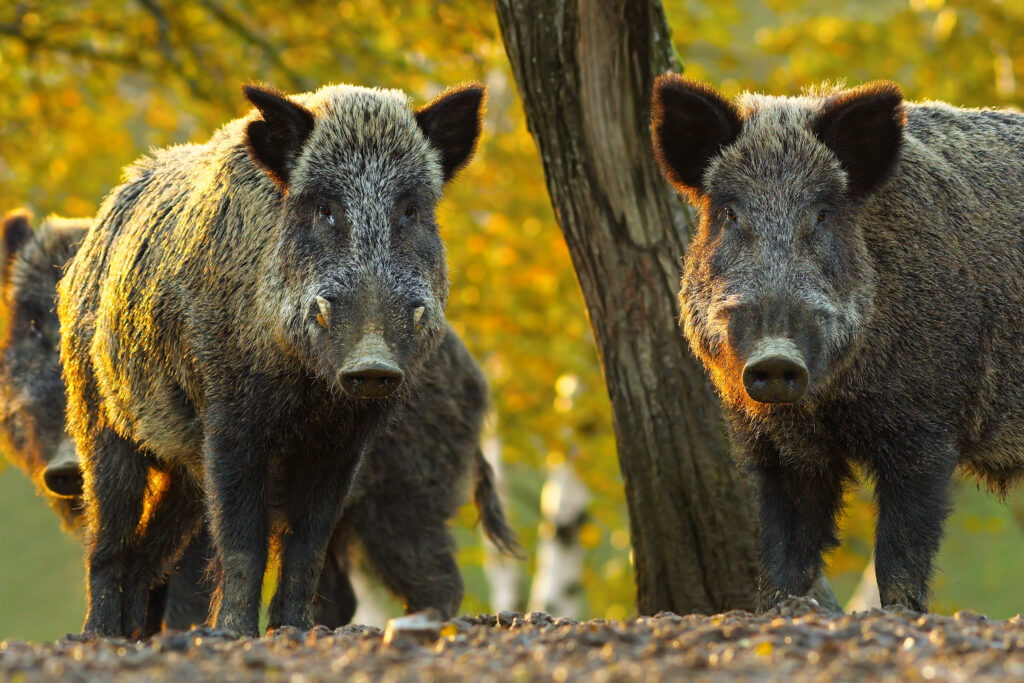
Feral pigs are strong animals with tusks that can hurt both people and other animals.
©iStock.com/taviphoto
Damage to Humans, Crops, and Wildlife
Feral swine cause significant harm to native species, ecosystems, buildings, humans, and agriculture (crops and animals). According to various estimates, there may be more than 6 million of them nationwide. The U.S. Department of Agriculture reckoned that the damage they wreak costs around $2.5 billion annually.
Wild boars are invasive species that significantly destroy local vegetation and wildlife. They compete with other creatures for food, ruin habitats, contribute to erosion, and prey on the young of threatened species like sea turtles.
Many parasites and pathogens, including bubonic plague, swine brucellosis, foot and mouth disease, and different intestinal worms, have possible carriers and spreaders among pigs. This implies that wild pigs could potentially infect livestock, wildlife, and humans. By extension, they contaminate water supplies.
Naturally, pigs enjoy rolling in the mud. However, those in the wild typically move around water bodies, including creeks, ponds, and streams. As a result, they leave behind waste that could be full of pathogens and parasites and can affect a water source.
Pigs can find delicious delights buried beneath the soil due to their keen sense of smell. After sensing something tasty, they start “rooting,” which is just a fancy word for digging lots of holes everywhere. Unfortunately, the destruction of crops, the impossibility of working the land, and the danger it poses to farm animals and equipment make this process utterly terrible for farmers.
Wild hogs are responsible for widespread harm, despite the impression that this problem only affects rural areas, parks, and wildlife habitats. These pests particularly like to eat at the parks and golf courses in suburban areas. In other cases, they have been known to destroy neighborhood lawns and gardens, leaving lasting harm after just one night.

After sensing something tasty, wild boars start “rooting,” which is just a fancy word for digging lots of holes everywhere.
©ENRIQUE ALAEZ PEREZ/Shutterstock.com
Wild Hogs in Texas
With an estimated wild hog population of 3 million across 253 of its 254 counties, the famous saying “everything is bigger in Texas” holds true. The Lone Star State has a feral hog infestation because it has the highest spread of this invasive species.
The biggest population densities of wild hogs can be found in East, South, and Central Texas, and they usually live in the white-tailed deer’s habitat. A relatively small number of feral hogs live in North and West Texas, if any. Nonetheless, reports suggest that populations in these places are starting to grow.
They can be found in a range of settings, from humid pine woods in East Texas to brushy areas in South Texas. Whenever they can find them, they prefer bottomlands, including rivers, creeks, and drainages. Although hogs are typically found in areas with high foliage cover and water nearby, they can also thrive in areas prone to drought.
The availability of food and cover determines the proportion of their home range. It can be up to 70,000 acres but is often less than 5,000. As a result, boars tend to move farther and have a wide habitat distribution.
Feral pigs like to wade in muddy, moist areas during the summer and never go far from dense cover. Their focus is on areas with access to food, particularly those with nut-producing trees or agricultural products.
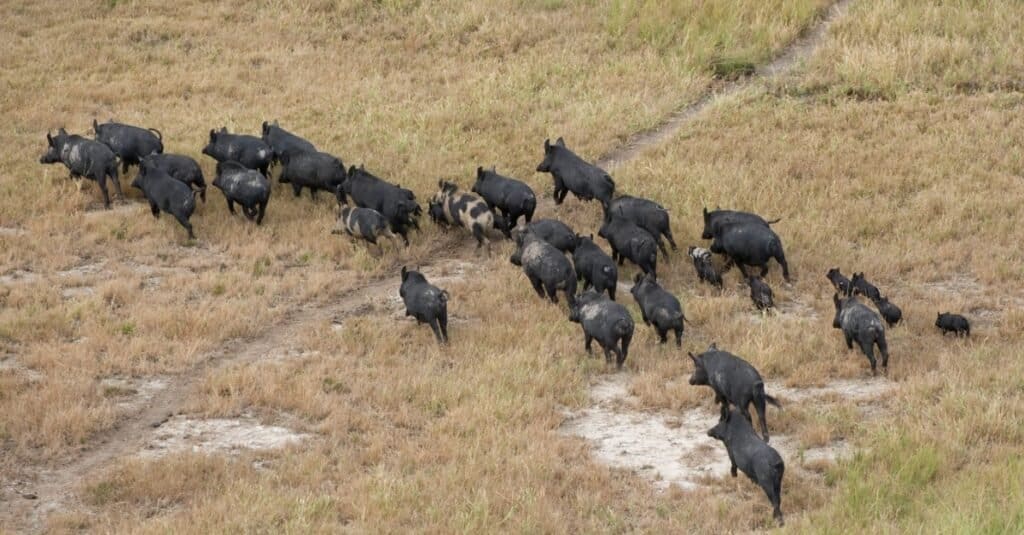
Texas has an estimated wild hog population of 3 million across 253 of its 254 counties.
©iStock.com/JohnCarnemolla
How Did Wild Hogs Get into Texas?
Hogs were most likely initially introduced to Texas more than 300 years ago by early Spanish explorers. Hog populations grew as colonialism expanded. They were a crucial supply of lard and preserved meat for the settlers.
Ranchers and hunters in Texas brought the first European wild hogs, known as “Russian boars,” into the state in the 1930s. Eventually, most animals ran away from game ranches, roamed freely, and bred with wild pigs. Actual European hogs are now almost extinct in Texas due to this crossbreeding.
Can You Hunt Wild Hogs in Texas?
Yes, you can hunt wild hogs in Texas. In fact, hunting the omnivores is encouraged within the state. The state is a haven for hog hunters, partly due to the fact that there are so many of them — the most of any state. The state’s legislation also makes hog hunting as easy as possible.
Before 2019, licenses were needed to hunt them. The Legislature, however, dropped that requirement. So instead, the sole prerequisite today is a hunter’s education course.
There’s no easy route to solving the feral hog infestation in Texas. Thus, implementing a single, comprehensive approach to solve the issue statewide takes a lot of work. On the other hand, Texans have devoted much of their time to local population management. As a result, clearing a ranch or farm of wild hogs is only a short-term fix.
This isn’t to discredit the lax hog hunting legislation in Texas. On the contrary, the laws are actually crucial for controlling the statewide feral hog population. Although not sufficient, hunters are thought to be able to eliminate 30% of Texas’s population annually.
Experts claim that the number would need to reach 70% merely to sustain present levels, given the extraordinary rate at which wild pigs can reproduce.
Helicopter Hog Hunting in Texas
Helicopter-based feral hog hunting has shown to be a highly efficient, albeit expensive, strategy for controlling local populations. The wild pigs tend to move quickly, scare easily, and seek cover in a difficult-to-navigate thicket, so they can be particularly challenging to hunt from the ground.
The hunters get to exterminate many more feral hogs than they otherwise could because of the helicopter’s speed and vantage position. But, of course, this is as long as they hit the target. In addition, helicopter hunting requires a license, unlike traditional hunting.
Trapping
This technique has grown in importance due to recent developments in trapping technology. Unfortunately, feral swine learn to evade some traps easily; thus, trappers have had to adapt to electronic doors, triggers, and wireless monitoring systems.
While a few hogs may be easy to kill in a single expedition using typical hunting methods, most will disperse and hide. This makes it hard to eliminate them altogether. However, a big corral trap can catch a sounder in a single capture.
But you must be careful since other species can also be lured into the trap. One of these strategies is to use bait that is especially alluring to pigs but is not always successful. In order to be prepared in case an animal like a deer stumbles into your trap, game wardens advise obtaining a hunting license.
Notably, wild pigs must be sent to a state-approved buying station if their meat is to be sold commercially. These stations then deliver them to a processing facility under the control of the United States Department of Agriculture.
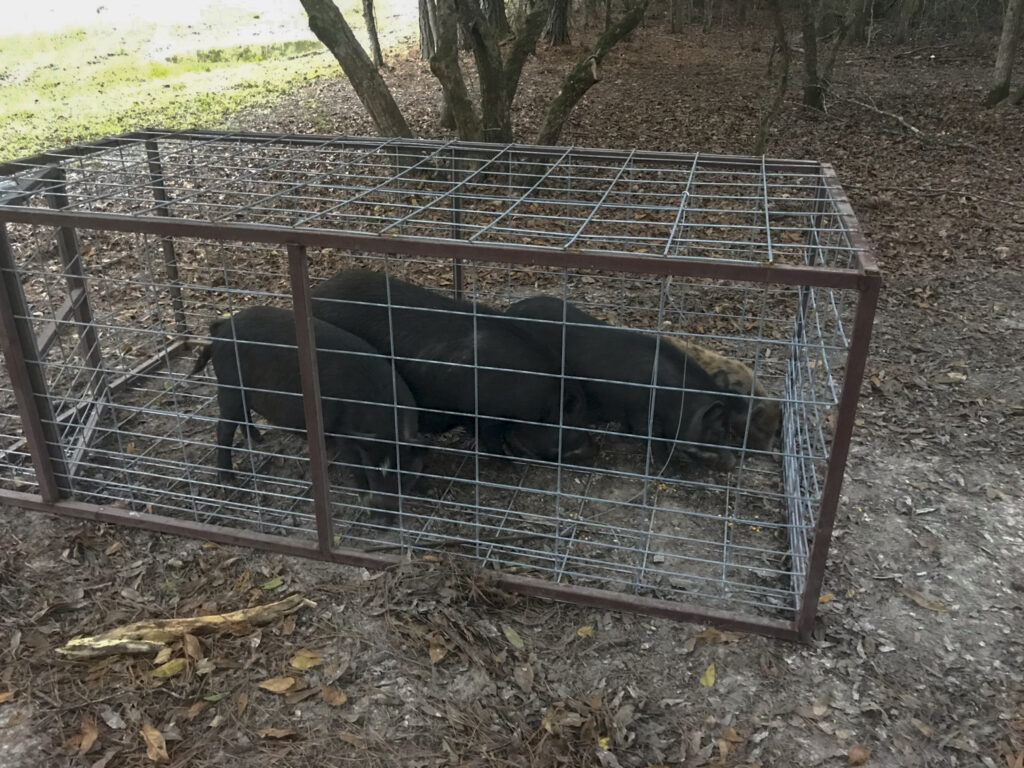
Trapping wild hogs is one method used to try and control the population though it is not always successful.
©iStock.com/Tim Bingham
Can You Eat Wild Hogs?
Yes, you can. The abundance of high-quality pork undeniably benefits the species’ invasion. While being much leaner than pork from farms, wild hog meat is very nutrient-rich. Many variables, such as size, gender, nutrition, and age, can affect the taste.
According to many hunters, the perfect meat comes from a female pig between three and six months old, but hogs can be hunted and used for various cuts. Try smoking your pig using the tried-and-true low-and-slow Texas BBQ technique if you find it to be a bit tough.
The photo featured at the top of this post is © iStock.com/chingkai huang
Thank you for reading! Have some feedback for us? Contact the AZ Animals editorial team.



